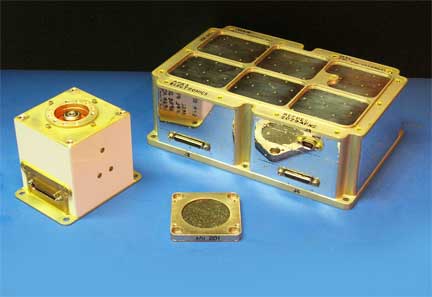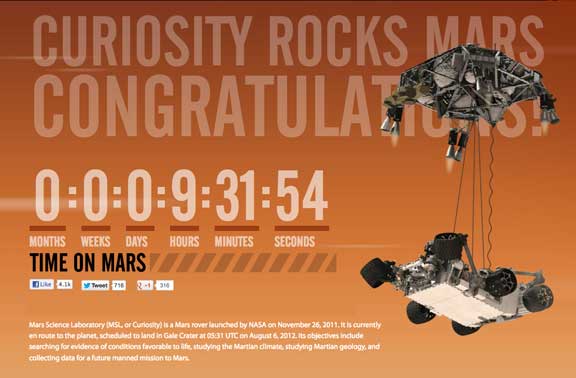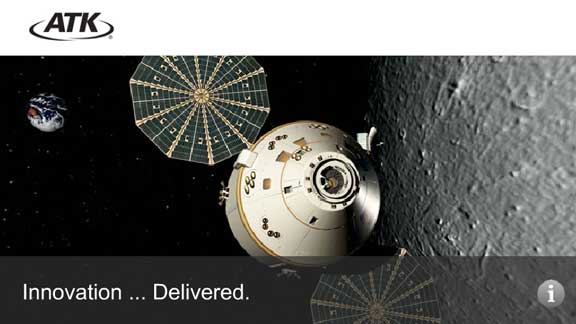[SatNews] Last night's (Sunday, August 5, 2012) landing of the Mars Science Laboratory (MSL), named Curiosity, was successful...
for a number of reasons, none the least of which were the roles played by leading companies in the industry. Some mentions...
- Aerojet, a GenCorp (NYSE:GY) company, announced that its monopropellant hydrazine thrusters helped guide NASA's...
...Mars Science Laboratory (MSL) to a successful landing on the red planet at 10:32 p.m. PT on August 5, 2012. The much-anticipated landing delivered the rover Curiosity to the Martian surface. Aerojet engines assisted with entry, descent and landing. The company's thrusters also provided attitude control and trajectory correction maneuvers during the MSL's transit to Mars. MSL carried eight Aerojet MR-111C-1.0 lbf thrusters, eight Aerojet MR-107U-68 lbf thrusters and eight Aerojet MR-80B 800-lbf thrusters with a throttleable thrust range of >100:1. The 68 lbf and the 800 lbf thrusters supported the actual landing.
In June of 2012, NASA reduced the MSL target landing area to about 12 miles long and four miles wide (20 kilometers by seven kilometers) on a site near the northern flank of Mount Sharp, inside Gale Crater on Mars. The landing timeline began with guided entry in the upper atmosphere of Mars and concluded with the sky crane drop-off of Curiosity and the remaining spacecraft fly-away. This was the most complicated landing ever attempted on a planet.
- ATK (NYSE: ATK) contributed technical and manufacturing expertise from the launch last year, through the nine-month flight to Mars, during descent to the surface, and now in the exploration phase of the mission. ATK’s Clearfield, Utah and Iuka, Mississippi, facilities built the lightweight composite heat shield, interstage adapter and boat tail sections of the United Launch Alliance Atlas V that launched Curiosity in November 2011.
ATK products supported the flight to Mars and the challenging descent to, and landing on, the Martian surface. ATK’s Commerce, California, facility designed and built five propellant tanks, two of which supplied propellant to cruise thrusters to guide the spacecraft on its journey to the Red Planet; the other three provided propellant to the descent thrusters that successfully contributed to the surface landing. ATK Engineering Services in Pasadena, California. supported the design development of the Terminal Descent Sensor, which guided the descent stage. ATK engineering teams in Pasadena, California, and Beltsville, Maryland, also provided key technical support to develop a number of the science instruments aboard the mobile laboratory. They provided the detail design engineering and supported the fabrication, integration and test of the rover’s Remote Sensing Mast Deploy Mechanism, as well as mechanical and thermal design and fabrication for the cornerstone Chemistry/Mineralogy (CheMin) instrument. CheMin is an X-ray diffraction and fluorescence instrument designed to identify and quantify the minerals in rocks and soils. Another major role included contributions to the design and development of a suite of instruments named Sample Analysis at Mars (SAM). These instruments will analyze samples of material collected and delivered by the rover’s robotic arm.
ATK Engineering Services in Pasadena, Calif. and Integrated Thermal Systems in Beltsville, Md. also provided support in the development of the thermal subsystem that protected Curiosity from the harsh environment it encountered on the Martian surface. At a design review, it was described as the most challenging thermal design ever seen.
- NASA's Mars Science Laboratory (MSL) touched down on the Red Planet today at 1:32 a.m. EDT on August 6th, marking the second time...
...a Canadian science instrument lands on Mars. The mission's rover, dubbed Curiosity, carries an instrument roughly the size and shape of a Rubik's cube provided by the Canadian Space Agency (CSA). Known as the Alpha Particle X-Ray Spectrometer (APXS), the device will probe the chemistry of rocks and soils on Mars to help determine if the planet ever was, or could still be today, an environment able to support microbial life. "In 2008, Canadians celebrated as NASA's Phoenix Mars Lander mission marked the first time we, as a country, landed Canadian technology on the surface of another planet," said Steve MacLean, President of the CSA. "Mars Science Lab is another first for Canada: the first time wereach out and "touch" Mars, since APXS will investigate the planet's surface."
An improved version of the instruments on Pathfinder, Spirit, and Opportunity, this latest version of APXS was developed specifically for MSL under the scientific leadership of Dr. Ralf Gellert of the University of Guelph, Principal Investigator for APXS. Dr. Gellert also heads the APXS science team, which is composed of members from the University of Guelph, the University of New Brunswick, NASA's Jet Propulsion Lab (a division of Caltech), the University of California, San Diego, Cornell University, the Rensselaer Polytechnic Institute and the Australian National University. With funding from the CSA, scientists from Brock University, the University of Western Ontario and the CSA are also participating in the mission as NASA-selected Participating Scientists.
The three components of the Canadian-built APXS
(from left to right): the sensor head, calibration target and main electronics unit.
Photo is courtesy of MDA.The CSA is investing $17.8 million in the design, construction, primary operations and scientific support of APXS. The CSA managed the development and construction of the instrument with MacDonald, Dettwiler and Associates Ltd. (MDA) as the prime contractor for APXS. The University of Guelph provided the scientific direction for the design and engineering support during the development, calibrated the APXS instrument and will lead the science operations for the instrument. Components of APXS were tested in Brampton, Montreal, Vancouver, Ottawa, Toronto and Guelph.




